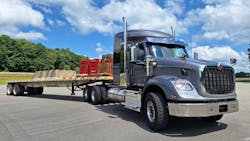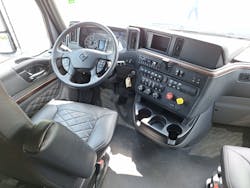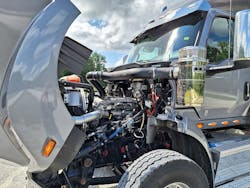Truck manufacturers’ use of vertical integration of componentry is not new, but some of the products are. Builders have updated engines to meet the latest exhaust emissions requirements and refined their automated transmissions for better performance.
An example was International Harvester, long known for its own gasoline and diesel engines. Navistar, its successor, continues the tradition but in a more limited way. It relies on Cummins for big-bore and medium-duty diesels while putting its resources into a 13-liter-class diesel, along with a proprietary automated manual transmission. Developed in collaboration with European partners, the two components seem to be real accomplishments.
I say that after a recent drive of an S13 integrated powertrain, in mid-summer at the Navistar Proving Grounds in northern Indiana. An S13 diesel and T14 AMT were in a long-nose HX (for Heavy eXtreme) tractor that was as much a highway cruiser as a vocational workhorse. It was hitched to a loaded steel flatbed, and I drove the rig on the facility’s 3-mile asphalt oval and over a gravel trail and several concrete shaker courses.
The long track represents highway travel, where the HX’s ride was comfortable. And the off-road paths test a truck’s toughness, which the HX evidently has a lot of. Over the rough surfaces, the cab and chassis seemed especially stout and there was little or no creaking, groaning, or banging. Nor did much vibration penetrate the air-ride suspensions on rear axles, cab, and seats.
Read also: Vertical integration gains in heavy trucks
The HX had the strongest 515-horsepower version of Navistar’s S13 diesel, running through a 14-speed T14, which will be standard in most International heavy-duty trucks and tractors using the S13. The new engine will eventually replace the current A26.
The diesel’s healthy horsepower and strong torque of up to 1,850 lb.-ft. easily propelled the rig. It grossed right at 80,000 pounds, said Jack Gergets, a test engineer who guided me around the grounds. That much output from just 12.7 liters begs the question: Who needs the optional Cummins X15 engine? Some would answer: for extra-heavy hauling and longer life, and maybe for better resale value in certain truck models.
From Europe through Alabama
The automated transmission is assembled by workers at Navistar’s Huntsville, Alabama, engine plant, with parts sourced from Traton, the parent company in Europe. Traton also owns Scania, whose engineers worked with Navistar counterparts to develop the gearbox for North American use, said Andy Hanson, Navistar’s vocational marketing manager.
The T14 has two low-low “crawler” gears, which means 12 normal ratios, including a direct-drive 13th gear and a 0.78 to 1 overdrive top gear. Subsequent ratios are close and even, which made for smooth acceleration. On level pavement with the selector set in D for drive, a dash readout said we started out in 4th and skip-shifted to 6th, 8th, and 10th, then, as road speed increased, used 11th, 12th, and 13th until settling in at 14th-overdrive.
The truck was governed at 65 mph and there we stayed except for the oval’s curves, where I instinctively slowed. Gergets said I could’ve stayed at 65 because the turns’ center and right lanes are nicely banked. Yeah, I’ve been here before and should’ve remembered.
Read also: International HX test drive highlights classy comfort
The powertrain has four operating modes: Economy, Performance (also called Balance), Performance Plus, and Off-Road—with shift points rising as more aggressive modes are punched in with a dash-mounted switch. In Econ, most upshifts came at 1,500 rpm or so.
Engineers cut weight from the T14 by using a single countershaft (vs. the common dual-shaft), and its reverse ratios are accomplished with a planetary gearset instead of flat gears, Hanson said. As many as six reverse ratios are available for special applications, but Navistar ships the transmissions with just two unless more are requested.
Allison torque-converter automatics can be spec’d for applications where there’s a lot of stopping and starting. A special engine rating of 370 horsepower and 1,250 lb.-ft. is available for use with lower-cost Allison 3000 series transmissions, while heavier and higher-priced 4000 series versions can be fitted to higher-power engines.
For vocational use, the T14 has several special functions that the driver can use. Among them: Rock Free, to extract a truck from mud or loose soil; Maneuver, for creeping with a crawler gear in tight quarters; and Manual, to hold a gear and lock out an up- or downshift, except to protect the engine from overrevving and “grenading.”
There’s also Hill Start, which keeps brakes applied while stopped on an up-grade for up to three seconds. In that time, the driver needn’t worry about the rig rolling backward and simply presses the accelerator to resume moving. Clutch engagement is smoother than most drivers could do with a manual clutch and tranny. (Competitors’ AMTs offer these features, too.)
Power take-off drives can be fitted to an engine’s front and rear, and a transmission’s rear and sides, using industry-standard mounts. This tractor’s T14 had a dual-drive PTO at its rear, at 4 o’clock, alongside the main output shaft for the driveline.
The engine’s Jacobs compression brake can make up to 470 retarding horsepower, enough to seriously slow the rig on short but steep downgrades on the proving grounds’ gravel trail. The Jake is controlled by pulling down on the selector stalk behind the steering wheel, from Off through three positions. On steep downgrades, revs rose to 2,000 and 2,100 to extract maximum performance.
Embracing SCR
The S13 diesel has double overhead camshafts and four valves per cylinder. Otherwise, Hanson said, it’s relatively simple, with a fixed-geometry turbocharger and wastegate instead of a complex (and costly) variable-vane turbo. There’s no EGR cooler, which is a troublesome part in many diesels. Exhaust-gas recirculation is still used, but not much—a far departure from the sadly unsuccessful EGR-only MaxxForce diesels.
Instead, the S13 employs two-stage selective catalytic reduction (SCR), using diesel exhaust fluid that chemically neutralizes oxides of nitrogen, a principal target of emissions regulations. There is no “seventh injector” because extra fuel does not keep the aftertreatment system warm; hot exhaust gas does.
Clean-burn combustion squeezes as much energy as currently possible from fuel and little soot is produced, Hanson said. As with other diesels, soot from fuel and ash from motor oil is collected by a diesel particulate filter. It’s boxed with the SCR chamber, but the S13’s DPF cannot be cleaned; instead, it must be replaced. Intervals are long, from 450,000 miles for vocational engines to 650,000 miles for highway engines running at 8.2 mpg or more.
Including the 370-horse version, there are six vocational ratings of the S13, all with torque curves tailored for on/off-road operations. You can now order the new engine in the HX, and it eventually will appear in other vocational models. Of course, on-road ratings of the S13 are available in highway trucks and tractors.
Notably, Navistar says this is the last internal combustion engine it will offer, as development is now concentrated on zero-emission powertrains, meaning battery-electric and fuel cell-electric vehicles. It predicts that by 2030, half the trucks it sells will have electric propulsion and by 2040, all of them will. That’s a ways away, but time flies; so if you’re wary of that e-future, better grab an S13 or another diesel while you can.
International HX Test Specs
Truck: International HX620, 6x4 vocational tractor, BBC 120 in., w/ 56-in. sleeper
Engine: International S13, inline 6-cyl. DOHC diesel, 12.7 liters (777 cu.in.), 515 hp @ 1,800 rpm, 1,850 lb.-ft. @ 900 rpm, w/ compression brake
Transmission: International T14 automated manual, 14-speed overdrive w/ two crawler gears
Front axle: 20,000-lb. Meritor MFS-20-133A with locking differentials on 20,000-lb. parabolic leafs, w/ Bendix ADB 22X air disc brakes
Rear axles: 46,000-lb. Meritor RT46-160P on 46,000-lb. Hendrickson PriMaax EX air-ride, w/ Bendix 165-7X air S-cam drum brakes
Tires and wheels: 22.5-in. Michelin radials on Alcoa and Accuride aluminum discs
Fuel tanks: Twin 120-gal. aluminum
Wheelbase: 258 in. DEF tank: 18-gal. plastic
Anti-lock braking system: Bendix 6-channel w/ electronic stability and automatic traction control
DEF tank: 18-gal. plastic
About the Author

Tom Berg
Tom Berg is widely acknowleged as one of the top truck writers in the industry. He has covered construction for more than 34 years, and has test-driven well over 150 trucks for Construction Equipment.


